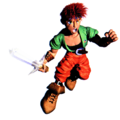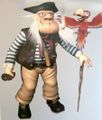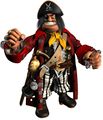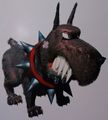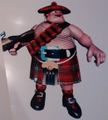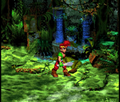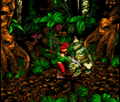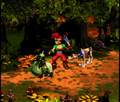Be sure to read our policy on citing sources before editing!
Difference between revisions of "Dream: Land of Giants"
(→Characters: whoops) |
m (→Characters: Why are these proper nouns?) |
||
| (31 intermediate revisions by 7 users not shown) | |||
| Line 1: | Line 1: | ||
{{DISPLAYTITLE:''Dream: Land of Giants''}} | |||
{{Infobox game | |||
|image=Dream Land of Giants title screen.png | |||
|size=256px | |||
|developer=[[Rare, Ltd.]] | |||
|console=[[wikipedia:Super Nintendo Entertainment System|Super Nintendo Entertainment System]]<br>[[Nintendo 64]] | |||
|released=Canceled | |||
}} | |||
{{Wikipedia}} | {{Wikipedia}} | ||
'''''Dream: Land of Giants''''' (codenamed '''''Project Dream''''') is an unreleased RPG game that was | '''''Dream: Land of Giants''''' (codenamed '''''Project Dream''''' or '''''Dream''''') is an unreleased RPG game that served as the basis for ''[[Banjo-Kazooie]]''. It was originally under development for the [[wikipedia:Super Nintendo Entertainment System|Super Nintendo Entertainment System]] and later ported to the [[Nintendo 64]]. | ||
The plot revolved around a young boy, Edson, who caused trouble with pirates. The Super Nintendo version of Dream used an isometric perspective and had a fairy tale-like theme. After transitioning to the Nintendo 64, the project became a more complex 3D RPG that had a greater emphasis on the pirate theme. Eventually, Dream was scaled back into a 2.5D linear platform game starring [[Banjo]] as the main character. The game was reworked into a 3D platformer similar to ''[[mariowiki:Super Mario 64|Super Mario 64]]'' and would become ''Banjo-Kazooie''. | |||
==History== | ==History== | ||
[[File:Dream N64 image.jpg|thumb|left|200px|The only screenshot of ''Dream'' made public prior to 2015]] | |||
For many years, not much information was known about ''Dream'', only one screenshot and some concept drawings were public. | |||
Along with that, near the end of May 2015, Tim Stamper brought up a rumor on Twitter that there were two prototype cartridges for ''Dream''. He had then allegedly found one of the rumored cartridges in his closet in early June, as he then began to tease the fans with a humorous scenario in which he had to capture it. As of current, the cartridge has successfully been captured, and Stamper uploaded photos of the cartridge itself, along with an opened view, showing its internal circuitry, especially the four ROM chips. Stamper has announced on his Twitter on July 20th, 2015, that he is slated to run the cartridge on the SNES. | |||
In July 2015, a blank sprite floppy of ''Dream'', along with storyboard images and concept art sheets, had surfaced on eBay UK. The auction ended on July 19th, 2015. | |||
More info was revealed in December 2015, when Rare published the A Rare Look at Dream video on YouTube. | |||
{{br|left}} | |||
==Development== | |||
[[File:Dream LoG screenshot 1.png|thumb|200px|A screenshot of the Super Nintendo version, showing Edson walk in the woods]] | |||
''Dream'' began development sometime in 1995 by the same development team as ''[[mariowiki:Donkey Kong Country 2: Diddy's Kong Quest|Donkey Kong Country 2: Diddy's Kong Quest]]''. The game was an isometric RPG for the Super Nintendo titled ''Dream: Land of Giants'', and it utilized the Silicon Graphics technology of the ''[[mariowiki:Donkey Kong Country (series)|Donkey Kong Country]]'' games but to a more advanced level.<ref name="retrogamer">"The Making of Banjo-Kazooie," Retro Gamer issue 36 (March 2007), pages 18–25</ref> The team decided upon the codename ''Dream'' because they wanted the game to have a fantastical, magical feel to it.<ref name="rrevealed">[https://www.youtube.com/watch?v=w72kj20YNA0 Rare Revealed: A Rare Look at Dream] on YouTube</ref> ''Dream'' was inspired by Japanese RPGs and LucasArts adventure games, and the team wanted to combine those games into one with a "Rare flavor."<ref name="retrogamer"/> | |||
As development progressed, ''Dream: Land of Giants'' became too large to fit on a Super Nintendo cartridge, and the Nintendo 64's introduction made the Silicon Graphics technology obsolete. Therefore, the team decided to port the game to the Nintendo 64.<ref name="retrogamer"/> Following this transition, the team gradually dropped fantasy-related elements as they did not want the game to become "too childish."<ref name="rrevealed"/> ''Dream'' was gradually being developed into a much larger RPG, featuring pirates rather than giants. [[Captain Blackeye]] was planned as the main antagonist in the Nintendo 64 version. | |||
The Nintendo 64 version of ''Dream'' ran into a number of difficulties. According to engineer [[Paul Machacek]], the team spent a lot of time writing level editors and creating environments, but they "couldn't quite get a hook of a game." [[Steve Mayles]] deemed Edson as out-of-place among the cast of pirates and "too generic" and nondescript to begin with, so the team experimented with replacing the boy with an animal protagonist.<ref name="rrevealed"/> The team tried recycling existing designs for non-playable characters, including "a dopey dog, a rabbit that looked like a man, and a bear." They gave the bear, who would eventually be named [[Banjo]], a backpack for storing his adventuring items and had him become the new protagonist. The game was too ambitious for Nintendo 64 hardware, as it lacked the processing power to maintain the environments at a steady framerate; taking inspiration from ''[[conkerwiki:Twelve Tales: Conker 64|Twelve Tales: Conker 64]]'', a recently developed title of the time, the team decided to recreate a different 3D platformer game that would become ''Banjo-Kazooie''. | |||
== | ==Gameplay== | ||
''Dream | ===Super Nintendo=== | ||
There is a known demo of ''Project Dream'' featuring a full introduction sequence and one level. The player would take control of Edson, a young boy wielding a sword, and he had a newly-befriended pet dog, Dinger, who assisted him during his adventure. Dinger had a primary ability of digging for buried objects and scampering off independently from Edson. The level took place in a forest and swamp filled with trolls, whom Edson would fight with his sword. Occasionally, a [[Stomponadon|massive dinosaur]] (only seen by its large foot) would attempt to crush Edson, and the shaking leaves and virtual camera warned the player when the dinosaur was approaching. | |||
==Characters== | ==Characters== | ||
[[File: | [[File:Edison artwork.png|thumb|150px|Edson, the protagonist.]] | ||
* | *[[Edson]] - A young adventurer who grew up in a village, but decided to leave and go to the "big wide world." He was planned to be the protagonist of the game. | ||
* | *[[Madeleine]] - A blond woman who wore a white dress and was Edson's girlfriend. | ||
* | *[[Banjo]] - Originally a minor supporting character who eventually became the protagonist of the final product, ''Banjo-Kazooie'', alongside [[Kazooie]]. | ||
*[[Captain Blackeye]] - An evil pirate who was planned to be the main antagonist, having his own crew and ship. | |||
* | *Grim Jim, Flintlock Jock and Big Belly - Three of Captain Blackeye's crew members. | ||
* | *Ripper - Captain Blackeye's dog and crew member. | ||
* | *Captain Cockeye - A captain who acted as a mentor to Edson, and was described as a "good pirate and a bit of a mad professor."<ref>[https://web.archive.org/web/20140822043530/http://grantkirkhope.com/cockeye.html ''Dream Compositions Cockeye'']</ref> | ||
*Unnamed rabbit - Planned to replace Edson after he started "losing his edge," but was eventually also replaced by Banjo. | |||
* | *Dinger - Edson's dog who followed him around and had many abilities that aided him during the game, being found inside a hole near the start and rescued by Edson. As the team felt Dinger was getting too many abilities and making Edson limited in comparison, they decided to give the protagonist all the abilities back. | ||
* | *[[Tiptup]] - Planned to be a minor supporting character, much like Banjo originally. | ||
*Unnamed dinosaur - A large dinosaur who walked through a room, shaking everything, making leaves fall and potentially damaging Edson. It eventually became [[Stomponadon]]. | |||
*Bully - A troll who "was like the Troll guarding the bridge in the story of '{{wp|Three Billy Goats Gruff|Billy Goat's Gruff}}'."<ref>[https://web.archive.org/web/20140822043541/http://grantkirkhope.com/bully.html ''Dream Compositions Bully'']</ref> | |||
* | |||
* | |||
==Music== | ==Music== | ||
[[Grant Kirkhope]] composed the music for ''Dream'' like he did for ''Banjo-Kazooie''. Kirkhope stated that he composed 107 tunes for ''Dream''. He has reused some of the songs in other games, namely the ''Banjo-Kazooie'' series. Kirkhope has also shared some songs on his personal website. [[David Wise]] also composed music for ''Dream'' while it was on Super Nintendo, but was eventually reassigned to work on the music for ''[[Diddy Kong Racing]]''. Two of his songs were included in ''[[Rare Replay]]''. | |||
==Gallery== | ==Gallery== | ||
===3D artwork=== | |||
<gallery> | <gallery> | ||
Dream LoG screenshot 1.png| | Edison artwork.png|Edson | ||
Dream LoG screenshot 2.png| | Dream 64 Edson art 1.jpg|Edson | ||
Dream LoG screenshot 3.png| | Dream 64 Edson art 2.jpg|Edson | ||
Dream SNES Edson art.jpg|Edson | |||
Edson faces.jpg|Edson's many faces | |||
Dream Dinger art 1.jpg|Dinger | |||
Dream Dinger art 2.jpg|Dinger | |||
Dream Madeleine art 1.jpg|Madeleine | |||
Dream Madeleine art 2.jpg|Madeleine | |||
Dream Captain Cockeye artwork.jpg|Captain Cockeye and his parrot | |||
Captain Blackeye Dream art.jpg|Captain Blackeye | |||
Dream Ripper artwork.jpg|Ripper | |||
Dream Grim Jim artwork.jpg|Grim Jim | |||
Dream Flintlock Jock art 1.jpg|Flintlock Jock | |||
Dream Flintlock Jock art 2.jpg|Flintlock Jock | |||
</gallery> | |||
===Miscellaneous=== | |||
<gallery> | |||
Dream Banjo concept.jpg|Banjo | |||
Dream Banjo concept 2.png|Banjo | |||
Dream Banjo concept 3.png|Banjo | |||
Dream Banjo concept 4.png|Banjo | |||
Dream Banjo concept 5.jpg|Banjo | |||
Piccolo concept art.jpg|[[Tooty|Piccolo]] | |||
Captain Cockeye Dream concept.jpg|Captain Cockeye | |||
Dream Storyboard Panel 08.jpg|Storyboard panel #8 | |||
Dream Storyboard Panel 10.jpg|Storyboard panel #10 | |||
Dream Storyboard Panel 11.jpg|Storyboard panel #11 | |||
Dream floppy disk.jpg|A blank ''Dream'' floppy disk, used for storing and transferring assets | |||
</gallery> | |||
===Screenshots=== | |||
<gallery> | |||
Dream LoG screenshot 1.png|Edson walking through the woods. | |||
Dream LoG screenshot 2.png|Edson attacking an enemy with his sword | |||
Dream LoG screenshot 3.png|Edson fighting an enemy, with Dinger at his side. | |||
Edison in Dream 64.png|The game, after being ported over to Nintendo 64. | Edison in Dream 64.png|The game, after being ported over to Nintendo 64. | ||
Banjo in Dream 64.png|A later version of ''Dream'', showing Banjo collecting fruit in a 2.5D environment. | Banjo in Dream 64.png|A later version of ''Dream'', showing Banjo collecting fruit in a 2.5D environment. | ||
Beak Barge in Dream 64.png|Kazooie using Beak Barge in a later build of ''Dream'' on Nintendo 64. | Beak Barge in Dream 64.png|Kazooie using Beak Barge in a later build of ''Dream'' on Nintendo 64. | ||
Banjo skater moves Dream 64.png|The idea behind Banjo using skater moves was short-lived. | Banjo skater moves Dream 64.png|The idea behind Banjo using skater moves was short-lived. | ||
Dream 64 Shoshinkai Show 1996.jpg|A cutscene from the version of ''Dream 64'' shown at Nintendo's {{wp|Nintendo Space World#Shoshinkai 1996|Shoshinkai 1996}} trade show | |||
</gallery> | |||
===Videos=== | |||
<gallery> | |||
Dream 64 Shoshinkai Show 1996.mp4|A cutscene from the version of ''Dream 64'' shown at Nintendo's {{wp|Nintendo Space World#Shoshinkai 1996|Shoshinkai 1996}} trade show | |||
</gallery> | </gallery> | ||
==External links== | ==External links== | ||
*[https://www.youtube.com/watch?v=w72kj20YNA0 Rare Revealed: A Rare Look at Dream] on YouTube | *[https://www.youtube.com/watch?v=w72kj20YNA0 Rare Revealed: A Rare Look at Dream] on YouTube | ||
*[http://web.archive.org/web/20130130142226/http://grantkirkhope.com/dream.html Dream Compositions - Grant Kirkhope's website] (Wayback Machine) | |||
{{ | ==References== | ||
[[Category: | <references/> | ||
{{Banjo-Kazooie series}} | |||
[[Category:Games]] | |||
[[Category:Canceled games]] | |||
[[Category:Dream: Land of Giants]] | |||
Latest revision as of 01:30, November 24, 2023
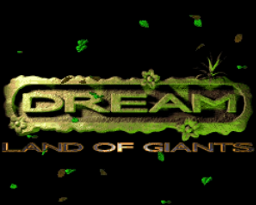
| |
| Developer | Rare, Ltd. |
| Console(s) | Super Nintendo Entertainment System Nintendo 64 |
| Release date(s) | Canceled |
| This article uses content from Wikipedia (view authors), and falls under the compatible Creative Commons license. |
Dream: Land of Giants (codenamed Project Dream or Dream) is an unreleased RPG game that served as the basis for Banjo-Kazooie. It was originally under development for the Super Nintendo Entertainment System and later ported to the Nintendo 64.
The plot revolved around a young boy, Edson, who caused trouble with pirates. The Super Nintendo version of Dream used an isometric perspective and had a fairy tale-like theme. After transitioning to the Nintendo 64, the project became a more complex 3D RPG that had a greater emphasis on the pirate theme. Eventually, Dream was scaled back into a 2.5D linear platform game starring Banjo as the main character. The game was reworked into a 3D platformer similar to Super Mario 64 and would become Banjo-Kazooie.
History[edit]
For many years, not much information was known about Dream, only one screenshot and some concept drawings were public.
Along with that, near the end of May 2015, Tim Stamper brought up a rumor on Twitter that there were two prototype cartridges for Dream. He had then allegedly found one of the rumored cartridges in his closet in early June, as he then began to tease the fans with a humorous scenario in which he had to capture it. As of current, the cartridge has successfully been captured, and Stamper uploaded photos of the cartridge itself, along with an opened view, showing its internal circuitry, especially the four ROM chips. Stamper has announced on his Twitter on July 20th, 2015, that he is slated to run the cartridge on the SNES.
In July 2015, a blank sprite floppy of Dream, along with storyboard images and concept art sheets, had surfaced on eBay UK. The auction ended on July 19th, 2015.
More info was revealed in December 2015, when Rare published the A Rare Look at Dream video on YouTube.
Development[edit]
Dream began development sometime in 1995 by the same development team as Donkey Kong Country 2: Diddy's Kong Quest. The game was an isometric RPG for the Super Nintendo titled Dream: Land of Giants, and it utilized the Silicon Graphics technology of the Donkey Kong Country games but to a more advanced level.[1] The team decided upon the codename Dream because they wanted the game to have a fantastical, magical feel to it.[2] Dream was inspired by Japanese RPGs and LucasArts adventure games, and the team wanted to combine those games into one with a "Rare flavor."[1]
As development progressed, Dream: Land of Giants became too large to fit on a Super Nintendo cartridge, and the Nintendo 64's introduction made the Silicon Graphics technology obsolete. Therefore, the team decided to port the game to the Nintendo 64.[1] Following this transition, the team gradually dropped fantasy-related elements as they did not want the game to become "too childish."[2] Dream was gradually being developed into a much larger RPG, featuring pirates rather than giants. Captain Blackeye was planned as the main antagonist in the Nintendo 64 version.
The Nintendo 64 version of Dream ran into a number of difficulties. According to engineer Paul Machacek, the team spent a lot of time writing level editors and creating environments, but they "couldn't quite get a hook of a game." Steve Mayles deemed Edson as out-of-place among the cast of pirates and "too generic" and nondescript to begin with, so the team experimented with replacing the boy with an animal protagonist.[2] The team tried recycling existing designs for non-playable characters, including "a dopey dog, a rabbit that looked like a man, and a bear." They gave the bear, who would eventually be named Banjo, a backpack for storing his adventuring items and had him become the new protagonist. The game was too ambitious for Nintendo 64 hardware, as it lacked the processing power to maintain the environments at a steady framerate; taking inspiration from Twelve Tales: Conker 64, a recently developed title of the time, the team decided to recreate a different 3D platformer game that would become Banjo-Kazooie.
Gameplay[edit]
Super Nintendo[edit]
There is a known demo of Project Dream featuring a full introduction sequence and one level. The player would take control of Edson, a young boy wielding a sword, and he had a newly-befriended pet dog, Dinger, who assisted him during his adventure. Dinger had a primary ability of digging for buried objects and scampering off independently from Edson. The level took place in a forest and swamp filled with trolls, whom Edson would fight with his sword. Occasionally, a massive dinosaur (only seen by its large foot) would attempt to crush Edson, and the shaking leaves and virtual camera warned the player when the dinosaur was approaching.
Characters[edit]
- Edson - A young adventurer who grew up in a village, but decided to leave and go to the "big wide world." He was planned to be the protagonist of the game.
- Madeleine - A blond woman who wore a white dress and was Edson's girlfriend.
- Banjo - Originally a minor supporting character who eventually became the protagonist of the final product, Banjo-Kazooie, alongside Kazooie.
- Captain Blackeye - An evil pirate who was planned to be the main antagonist, having his own crew and ship.
- Grim Jim, Flintlock Jock and Big Belly - Three of Captain Blackeye's crew members.
- Ripper - Captain Blackeye's dog and crew member.
- Captain Cockeye - A captain who acted as a mentor to Edson, and was described as a "good pirate and a bit of a mad professor."[3]
- Unnamed rabbit - Planned to replace Edson after he started "losing his edge," but was eventually also replaced by Banjo.
- Dinger - Edson's dog who followed him around and had many abilities that aided him during the game, being found inside a hole near the start and rescued by Edson. As the team felt Dinger was getting too many abilities and making Edson limited in comparison, they decided to give the protagonist all the abilities back.
- Tiptup - Planned to be a minor supporting character, much like Banjo originally.
- Unnamed dinosaur - A large dinosaur who walked through a room, shaking everything, making leaves fall and potentially damaging Edson. It eventually became Stomponadon.
- Bully - A troll who "was like the Troll guarding the bridge in the story of 'Billy Goat's Gruff'."[4]
Music[edit]
Grant Kirkhope composed the music for Dream like he did for Banjo-Kazooie. Kirkhope stated that he composed 107 tunes for Dream. He has reused some of the songs in other games, namely the Banjo-Kazooie series. Kirkhope has also shared some songs on his personal website. David Wise also composed music for Dream while it was on Super Nintendo, but was eventually reassigned to work on the music for Diddy Kong Racing. Two of his songs were included in Rare Replay.
Gallery[edit]
3D artwork[edit]
Miscellaneous[edit]
Screenshots[edit]
A cutscene from the version of Dream 64 shown at Nintendo's Shoshinkai 1996 trade show
Videos[edit]
A cutscene from the version of Dream 64 shown at Nintendo's Shoshinkai 1996 trade show
External links[edit]
- Rare Revealed: A Rare Look at Dream on YouTube
- Dream Compositions - Grant Kirkhope's website (Wayback Machine)
References[edit]
- ↑ a b c "The Making of Banjo-Kazooie," Retro Gamer issue 36 (March 2007), pages 18–25
- ↑ a b c Rare Revealed: A Rare Look at Dream on YouTube
- ↑ Dream Compositions Cockeye
- ↑ Dream Compositions Bully



